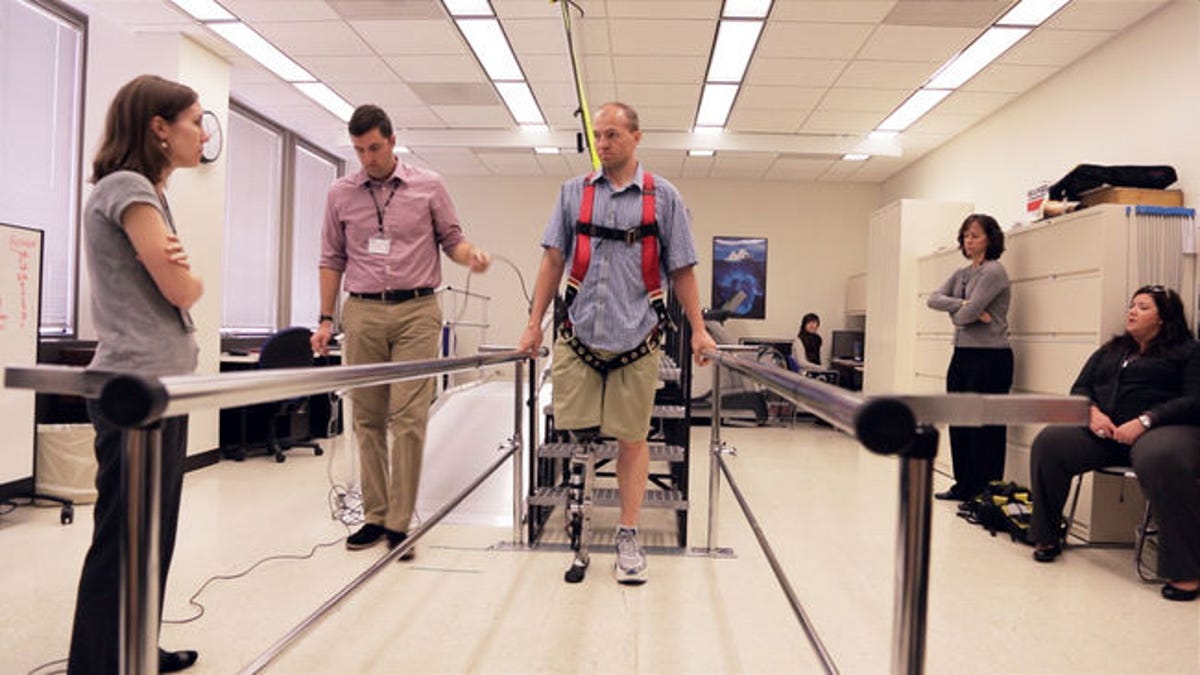Amputee to climb building's 103 flights with mind-controlled leg
This weekend, Zak Vawter could take a huge step for amputees everywhere -- and for a state-of-the-art prosthetic device that affords a more natural gait.

This Sunday, amputee Zak Vawter will stand at the foot of Chicago's Willis Tower and focus his thoughts on climbing. If all goes according to plan, his bionic leg will listen to those thoughts and he'll ascend 103 flights without a hitch.
Vawter, who lost his right leg in a motorcycle accident in 2009, will be wearing a cutting-edge, thought-controlled prosthetic that's about to make a very public debut. He'll head up the 1,451-foot skyscraper (also known as Sears Tower) as part of SkyRise Chicago, an indoor stair-climbing fund-raising event for the Rehabilitation Institute of Chicago (RIC). About 2,700 other climbers will join him.
Following his amputation, Vawter underwent a surgical procedure called "=http: www.ric.org="" conditions="" prosthetics-orthotics="" services="" bionic="" "="">targeted muscle reinnervation" originally pioneered by the RIC's Center for Bionic Medicine for upper-arm amputees.
The operation reassigns nerves that once controlled a lost limb, allowing amputees to have more natural control of prosthetic devices. In Vawter's case, this meant rerouting the residual nerves that normally would carry signals to his lower leg by attaching them to his hamstring.
Vawter, 31, lives in Seattle with his wife and two children but travels to Chicago every few months to work with RIC software engineers, physical therapists, and doctors to refine the control mechanisms of the bionic leg. The unique limb has a powered knee and ankle that work in unison, and it reads the wearer's intent. When Vawter pushes on the device to stand up, for example, it pushes back on him, propelling him up.
"One of the biggest differences for me is being able to take stairs step-over-step like everyone else," Vawter, a software engineer, said in a news release. "With my standard prosthesis, I have to take every step with my good foot first and sort of lift or drag the prosthetic leg up. With the bionic leg, it's simple, I take stairs like I used to, and can even take two at a time."
The leg also features an "anti-stumble" feature; if it senses that its user is starting to stumble, it lifts to avoid obstructions and plants on the floor to optimize balance.
Prosthetic devices seem to be getting stronger and more sophisticated by the day. The latest BeBionic hand, for example, works by detecting faint electrical signals in the user's arm skin that are amplified by the hand's electronics and translated into one of 14 possible grips. Development on bionic legs for paraplegics continues to progress apace.
We have reported previously on Vawter's lower-limb prosthetic, as it's been under development at Vanderbuilt University's Center for Intelligent Mechatronics for approximately eight years. It weighs about 9 pounds and can operate at normal levels of activity for roughly three days without recharging the battery. Studies, according to the Nashville university, have shown that users equipped with the device naturally walk 25 percent faster on level surfaces than when they use passive lower-limb prosthetics. That is because it takes users 30 percent to 40 percent less of their own energy to operate.
Others who have collaborated on the neural-controlled prosthetic leg include the University of New Brunswick, MIT, and URI. The last time we checked in on the prototype limb, it was undergoing extensive testing by Craig Hutto, a young man who lost his leg in a shark attack. Vawker's uphill trek this weekend marks the leg's most high-profile appearance to date, and there's no doubt Hutto and many others will be cheering him on.

